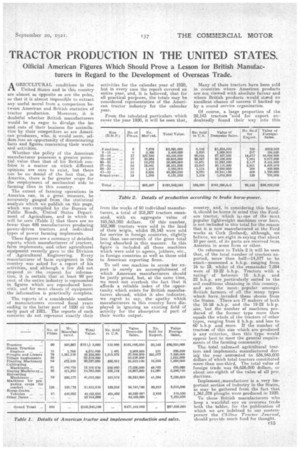TRACTOR PRODUCTION IN THE UNITED STATES.
Page 9

If you've noticed an error in this article please click here to report it so we can fix it.
Official American Figures Which Should Prove a Lesson for British Manufacturers in Regard to the Development of Overseas Trade.
A GRICULTTJRAL conditions in the
United •Stat-es and in this countryare almost as opposite aa are the poles, so that it is almost impossible to extract any useful moral from a comparison between American and British statistics of tractor production. Moreover; it is doubtful whether British manufacturers would be as eager to divulge the ins and outs of 'their business for assimilation by their competitors as are American producers, who, it would seem, seldom lose an opportunity of disseminating facts and figures concerning their works and activities.
Whether the policy of the American: manufacturer possesses is greater potential value than that of his British confrere is a matter on which different opinions are sure to exist, but there can be nodenial of the fact that, in America, there is far greater scope for the employment of mechanical aids to farming than in this country.
The extent of farming operations in America can, in a great measure, be accurately gauged from the statistical analysis which we publish on this page, which was compiled by the Bureau of Public Roads, United States Department of Agriculture, and in which it will he seen (Table 1) that there are no fewer than 498 manufacturers producing power-driven tractors and individual types of power. farming implements.
These fipres are a summary of detailed reports w. rob manufacturers of tractors, farm implements, and other agricultural equipment recently gave to the Division of Agricultural Engineering. Every manufacturer of farm equipment in the country was asked for a report of his activities, and although a few did riot respond to the request for information, it is certain that at least 99 per cent. of the entire industry is represented in figures which are reproduced herewith, and for most classes of equipment the information is practically complete.
The reports of a considerable number of rnanuraCturers covered fiscal years ending in the latter part of 1920 or the early part of 1921. The reports of such concerns tl.0 not represent exactly their activities for the calendar. year of 1920, but in every case the report covered an entire year, and, it is believed, that for all practical purposes, the totals may be considered representative of the American tractor industry for the calendar year.
From the tabulated particulars which cover the. year 1920, it will be seen that, from the works of 90 individual manufacturers, a total of 203,207 tractors emanated, with an aggregate value of
193,563,000 dollars. Of this number, 162,988 tractors were sold in the land of their 'origin, whilst 29,143 were sold for service in foreign countries, slightly less than one-seventh a the gross total being absorbed in this manner. In this figure -is included all those machines which were sold to agents, jobbers, etc., in foreign countries as well as those sold to American exporting firms.
To sell one machine in seven for export is surely an accomplishment of which American manufacturers should be justly proud, but, at the same time, we must not overlook the fact that it affords a reliable index of the opportunity which exists for British manufacturers abroad, whilst it also indicates, we ,regret to say, the apathy which manufacturers in this country have displayed in ignoring an existing field of activity for the absorption of part of their works output. Many of these tractors have been sold in countries where American products are not viewed with absolute favour and where British products would stand an excellent chance of success if backed up by a sound service organization.
Of course, a large proportion of the 29,143 tractors -sold for export undoubtedly found their way into this
country, and, in considering this factor, it, should be borne in mind that the Fordson tractor, which is: one of the molt popular lightweight machines over hero, is not included in this total for the reason that it is now manufactured at the Ford works at Cork (Ireland), although, we believe, we are right in saying that about 10 per cent. of its parts are received from America in some form or other.
. On reference to Table 2 it will be seen
that, of the total number of tractors exported, more than half-14,577 to be exact-possessed a b.h.p. ranging from 16 to 18, whilst of the remainder 7,884 were of 19-22 b.h.p. Tractors with a rating' of between 16 b.h.p. and 22 b.b.p. are ,particularly suited to the soil conditions obtaining in this country, and are the most. popular amongst British farmers of all the many types which have , invaded these shores from the States. There are 17 makers of both the 16-18 a.b.p. and the 19-22 b.h.p. size, butthe number of machines produced of the former type more than equals the whole of the tractors of other types, ranging from 8 b.h.p. and less to 60 b.b.p sod .more. If the number of tractoas of this size which are produced is any criterion, then this type would appeal best-to meet the general requirements of the farming community.
The total vablesof agricultural trac tors and implements manufactured during' the year •antranited to 536,945,000 dollars of which total tractors constituted more:than. one-third. The total value of foreign trade was 66,626,000 dollars, or about one-eighth of' the, value of all pro-, duct ions.
ImplementOnanufacture is a very important section of industry in the States, as may be gathered from the fact that 1,361,578 ploughs were produced in 1920.
To those .British manufacturers who keep a watchful eye on overseas trade both the tables, for the publication of which we ate indebted to our contemporary the Chilton Tractor Journal, should provide much food for thought.
































